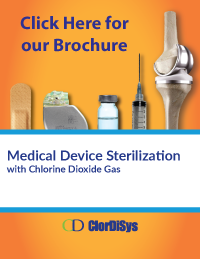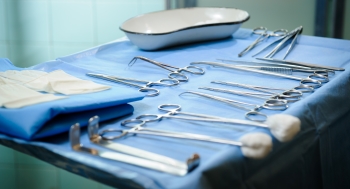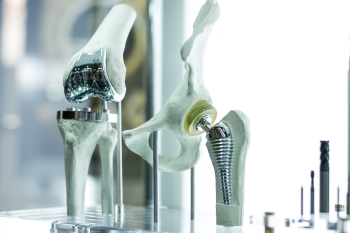Sterilization of Medical Devices

Gaseous chlorine dioxide (CD) is the closest alternative to EO sterilization. We can sterilize your Medical Device at our New Jersey
Contract Sterilization facility which is registered with the US FDA (#3013115071). Since CD is non-flammable, non-explosive,
and non-carcinogenic, many customers are choosing to purchase sterilization chambers from us and bringing sterilization into their
own facility. This is a major paradigm shift for the industry since most facilities would not want to bring EO in-house because of
the many dangers associated with it as well as it’s associated regulatory risks. Installation and equipment costs are significantly
lower with CD since there is no need for damage limiting construction, intrinsically safe wiring, expensive abatement systems, or
energy intensive steam heated chambers. Available chamber sizes include small vessels, as well as 1, 2, 3, and 4 pallet versions.
Bringing sterilization in-house has the benefits of reducing processing time by eliminating shipping time; reducing costs by
eliminating shipping costs as well as Contract Sterilization costs; as well as getting product through the system weeks to
months sooner. ClorDiSys CD is registered as a sterilant gas (EPA Registration 80802-1) and our QMS is certified to ISO 13485:2016.
The FDA is very open to new technologies to replace EO and there are approved devices on the market that have been sterilized at
our facility using CD gas. A device is also approved for sale in the EU with a CE mark utilizing ClorDiSys’ CD gas technology.
Gaseous chlorine dioxide (CD) was extensively studied as a sterilant for Medical Devices by both Baxter and Johnson & Johnson in the 1990’s. Both companies saw significant advantages of CD for sterilizing medical devices and performed successful testing on surgical kits, suture products, artificial joints, interocular lenses, pre-filled syringes, bioabsorbables, electronic sensors, battery powered devices, and may others. Since CD is an ambient temperature sterilization method, cold-chain products are another growing application. Fast forward to today’s environment with EtO facility shortages and potentially explosive 100% EO mixtures rather than the blended Oxyfume of the past and the need for an EtO replacement is more urgent than ever. In December of 2019, the FDA requested ClorDiSys to present on our CD technology in Washington DC. Similar to EO, our CD process is registered as a sterilant with the US EPA (registration number is #80802-1) and our NJ facility is also registered with the FDA as a Contract Sterilization facility (Registration #3013115071). The CD process can also be brought back in-house to save both costs and shipping time. Most Medical Device manufacturers do not want to perform in-house sterilization utilizing EO because of the liabilities of having a carcinogenic and explosive compound on site. The cost of a system, including the Damage Limiting Construction (DLC) featuring walls that are built to explode outward and Class 1 Div. 1 electrical installation, is extremely expensive. A CD system on the other hand has none of those costs or liabilities. Cycles are quick and simple being as short as a few hours in many cases. No special rooms for extensive aeration are required.
ClorDiSys' sterilization process follows ISO 14937 and can assist with both Cycle Development and Validation to enable the use of CD to be as simple as possible. CD is very similar to EO in how it is utilized, the type of devices that can be sterilized, and the SAL sterilization levels that can be attained. An integrated UV-VIS spectrophotometer measures and controls the gas concentration ensuring the efficacy of every cycle. Redundant sensors allow for parametric release. Both are gasses but CD is not explosive or carcinogenic and leaves no harsh residues. Residuals are typically below detectable levels of chlorites, chlorates, and chlorides which are non-carcinogenic, non-cytotoxic and non-teratogenic. CD cycle times are much shorter since total aeration time is typically under 1 hour. ClorDiSys has a draft Device Master Reference file available as a guide. Devices can be packaged in Tyvek pouches, display boxes, or final shipping containers. CD is friendly to most materials and electronics. Since CD chambers operate at ambient temperatures, they offer an improved process for temperature sensitive devices.
Chlorine dioxide is the method usually recommended when devices have imbedded batteries which are not affected by CD. CD does not get absorbed into materials like EO does, so an aeration time of under 30 minutes is typical. Chlorine dioxide is a true sterilant gas and works at true ambient temperature. The boiling point of CD is low, at -40°C. CD gas will not condense on devices. It is a surface sterilant, therefore CD gas can sterilize prefilled syringes, while maintaining drug integrity, and medical devices with complex geometries.
CD is also not listed as a carcinogen. In almost all locations, it can simply be exhausted to the environment rather than needing to be scrubbed with hazardous solutions. For situations where direct exhaust is not available, carbon-based scrubbers can be utilized. It is non-flammable and non-explosive at use concentrations, so it does not require expensive damage limiting construction.
In-house treatment costs can be as low as $5 per load.


The CD Gas Advantage
Chlorine dioxide gas sterilization is ideal for sensitive biotech products and improves supply chain efficiency:
- ClorDiSys' CD Gas is an EPA registered sterilant, making it effective against all viruses, bacteria, fungi and spores
- Non-carcinogenic
- Ambient temperature sterilization (0°C - 50°C) - can be customized for unique applications
- Adjustable vacuum levels - can be customized for unique applications
- Quick aeration - does not get absorbed in most materials
- Short cycle times - typically 2 to 8 hours including aeration
- Non-explosive
- Safe and easy to bring in house - reduces manufacturing time and cost
- Able to sterilize cellulosic materials such as packaging, labels, boxes and IFU's
- Emissions are reduced to zero chlorine dioxide by utilizing a carbon scrubber
Aerates Rapidly - Minutes vs. Days
Properties as a gaseous surface sterilant with a low boiling point, coupled with the low CD sterilant concentrations, translates into rapid aeration of the sterilization chamber and exposed products. CD does not permeate or become absorbed in materials to the same degree as other methods, greatly reducing the overall cycle time of the sterilization process and eliminating the lengthy post-sterilization aeration.
Low Residue Levels
CD’s properties combined with the rapid aeration process results in residues typically below detectable levels on product and packaging. CD’s sterilant residues are typically below detectable levels of chlorites, chlorates, and chlorides which are non-carcinogenic, non-cytotoxic and non-teratogenic. Sterilized packages and products may be handled immediately after the cycle.
Flexible to Design Custom Cycles
| Process Parameter | Range |
| CD Gas Concentration | From 1 mg/L to 30 mg/L |
| Exposure Time | Varies with Application |
| Door-to-Door Time | 2-8 Hours |
| Relative Humidity | Typically 65-90% |
| Depth of Vacuum | 5-101 kPa |
| Chamber Temperature | Ambient |
Compatible with Medical Device Materials and Packaging

CD is less oxidative than traditional oxidizing sterilants like hydrogen peroxide, ozone, nitrogen dioxide, and peracetic acid. ClorDiSys has tested
many medical device materials including non-ferrous metals, polymers, batteries, tissues, bone products, and collagens. Compatible materials
showed no increase in cytotoxic response. The true room temperature performance of the CD process allows temperature sensitive materials to
be processed.
CD’s sterilization process is compatible with commonly used sterile barrier packaging. This includes: non-woven polypropylene, Tyvek® pouches,
Tyvek®-Mylar® pouches, plastic tubs with Tyvek® lids as well as cellulosic materials such as paper and cardboard.
| Compatible Materials* | |||
| Stainless Steel Aluminum Copper Glass / Ceramic Fluoropolymers Most gasket materials |
Polyethlene Polypropylene PET / PETG Polystryene Polysulfones PEEK |
Polyetherimide Polycarbonate Cycline Olefins PVC Silicone Hypalon |
Thermoplastic Elastomers Titanium Gold Platinum Cardboard Most Inks |
| *This list is not exhaustive. Specific testing with your device is always recommended. | |||
Current Applications
Below is a list of applications that CD gas has been used for. Please contact us for more information on any of these applications or to explore additional applications not listed below.
| Sample Applications |
| Implantable Contact Lenses |
| Artificial Joints |
| Suture Products |
| Bones and Bone Powders |
| Surgical Kits |
| Datwyler Stoppers |
| Endoscopes |
| Electronic Devices |
| Cold-chain Products |
| Bioabsorbable Products |
| Pre-filled Syringes |
